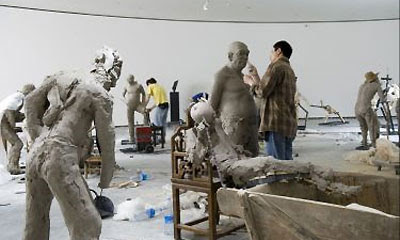.jpg)
Friday, 31 July 2009
Friday, 24 July 2009
Thursday, 23 July 2009
Wednesday, 22 July 2009
Friday, 17 July 2009
Alberto Giacometti and Edouardo Chillido






While I am here I caught one episode of a life drawing programme last Friday on Channel 4 and I joined in was annoyed that it wasn't on again this week so I am going to go to Life drawing class next term come what may ...nota bene
Eduardo Chillida Juantegui (1924–2002) was a Spanish Basque sculptor notable for his monumental abstract works. He received the prestigious Wolf Prize in Sculpture in 1985.
Before becoming a sculptor he had been the goalkeeper for Real Sociedad, San Sebastián's football team.
Chillida's earliest sculptures concentrated on the human form (mostly torsos and busts); his later works tended to be more massive and more abstract, producing many monumental public works. Chillida himself tended to reject the label of "abstract", preferring instead to call himself a "realist sculptor".
At their best his works, although massive and monumental, suggest movement and tension. For example, the largest of his works in the United States, "De Musica" is an 81-ton steel sculpture featuring two pillars with arms that reach out but do not touch. Much of Chillida's work is inspired by his Basque upbringing, and many of his sculptures' titles are in the Basque language Euskera. A large body of his work can be seen in the Basque city, San Sebastián (Donostia), including El peine del viento (The comb of the wind) installed in the (often stormy) sea in La Concha bay at San Sebastian.
His steel sculpture "De Música III" was exhibited at the Yorkshire Sculpture Park in the UK, as part of a retrospective of Chillida's work.
There is an outdoor sculpture garden dedicated to his work in Hernani, Spain, near San Sebastian
Before becoming a sculptor he had been the goalkeeper for Real Sociedad, San Sebastián's football team.
Chillida's earliest sculptures concentrated on the human form (mostly torsos and busts); his later works tended to be more massive and more abstract, producing many monumental public works. Chillida himself tended to reject the label of "abstract", preferring instead to call himself a "realist sculptor".
At their best his works, although massive and monumental, suggest movement and tension. For example, the largest of his works in the United States, "De Musica" is an 81-ton steel sculpture featuring two pillars with arms that reach out but do not touch. Much of Chillida's work is inspired by his Basque upbringing, and many of his sculptures' titles are in the Basque language Euskera. A large body of his work can be seen in the Basque city, San Sebastián (Donostia), including El peine del viento (The comb of the wind) installed in the (often stormy) sea in La Concha bay at San Sebastian.
His steel sculpture "De Música III" was exhibited at the Yorkshire Sculpture Park in the UK, as part of a retrospective of Chillida's work.
There is an outdoor sculpture garden dedicated to his work in Hernani, Spain, near San Sebastian
Tempus fugit very easily...





No longer hot...but it is Fair Friday.
Pal from Germany suggests picking up nearest book finding page 56 and sentence 5 and putting such on facebook...this done got me back in touch with zeitgeist approaches.
I had to use, what I feel was a tad prentious book namely an art book about Alberto Giacometti AND it was on the coffee table...but there you are got me thinking about picking and recording a random sentence from every book I take out of the library from now on. I am going to stick with 56 as it means something to me - again I like to know something that no one but me knows...sad bint that I am...but i am going to pick sentence 6..not least because I liked the sentence that followed better than the one I put on facebook. I will put them hear when I have enough to make sense or nonsense...feel a bit like David Bowie.
Right enough said Project Fair Friday is underway..watch this space.
PS and Nota Bene (Nota bene is a Latin phrase meaning "note well"[nb 1]. It is in the singular imperative mood, instructing one individual to note well the matter at hand. (The plural form is notate bene.) In present-day English, it is used to draw the attention of the reader to a certain (side) aspect or detail of the subject on hand, translating it as "pay attention" or "take notice". It is often written in the abbreviated form: N.B)
S>T>ART this will mean something to those it means something to another project begun S>T>ARTing from yesterday
I chose pink on purpose
Wednesday, 1 July 2009
Subscribe to:
Comments (Atom)





























